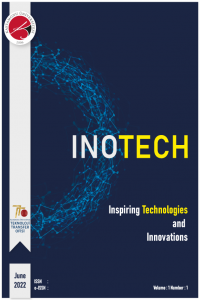Acceptance of E-Book Usage During COVID-19 Pandemic Using Technology Acceptance Model
Acceptance of E-Book Usage During COVID-19 Pandemic Using Technology Acceptance Model
___
- Agarwal, R., & Karahanna, E. (2000). Time flies when you’re having fun: Cognitive absorption and beliefs about information technology usage. MIS Quarterly, 24(4), 665-694.
- Ajzen, I. (1985). From intentions to actions: A theory of planned behaviour. Springer.
- Azjen, I., & Madden, T. (1986). Prediction of goal-directed behavior: Attitudes, intentions, and perceived behavioral control. Journal of Experimental Social Psychology, 22(5), 453-474.
- Bagozzi, R. P. (2007). The Legacy of the technology acceptance model and a. Journal of the Association for Information, 8(3).
- Bandura, A. (1997). elf-efficacy: Toward a unifying theory of behavioral change. Psychological Reports, 84(2), 191-215.
- Brown, B. (1930). The Readies. Rice University Press.
- Bruner, G. C., & Kumar, A. (2005). Explaining consumer acceptance of handheld internet devices. Journal of Business Research, 58(5), 553-558.
- Bryson, A. (2014). Medieval Studies and the Computer. Elsevier Science.
- Chang, M. Y., Chou, W. H., Yin, C. P., & Lin, C. I. (2011). ERP post-implementation learning, ERP usage and. The PACIS 2011 proceedings. Brisbane, Queensland.
- Compeau, D. R., & Higgins, C. A. (1995). Computer self-efficacy: Development of a measure and initial test. MIS Quarterly, 19(2), 189-211.
- Compeau, D., Higgins, C. A., & S.Huff. (1999). Social cognitive theory and individual reactions to computing technology: A longitudinal study. MIS Quarterly, 23(2), 145-158.
- Davis, B. W. (1989, August). User Acceptance of Computer Technology: A Comparison of Two Theoretical Models. Management Science, 982-1003.
- Doswell, W., Braxter, B., Cha, E., & Kim, K. (2011). Testing the Theory of Reasoned Action in Explaining Sexual Behavior Among African American Young Teen Girls. Journal of Pediatric Nursing, 26(6), 45-54.
- Elyazgi, M. G., Nilashi, M., Ibrahim, O., Rayhan, A., & Elyazgi, S. (2016, January 10). Evaluating the Factors Influencing E-book Technology Acceptance. Journal of Soft Computing and Decision, 11-25.
- Falcone, J. (2012, December 17). Kindle vs. Nook vs. iPad: Which e-book reader should you buy? https://www.cnet.com/news/kindle-vs-nook-vs-ipad-which-e-book-reader-should-you-buy/
- Fornell, C., & Larcker, D. F. (1981). Evaluating structural equation models with unobservable variables and measurement error. Journal of Marketing Research, 18(1), 39-50.
- Gardiner, E. A. (2010). The Oxford Companion to the Book. Newyork: Oxford University Press.
- Gefen, D., & Straub, D. (2000). The relative importance of perceived ease-of-use in IS adoption: A study of e-commerce adoption. Journal of AIS, 1(8), 1-28.
- Guillermo, G. (2013, January 25). Doña Angelita, la inventora gallega del libro electrónico. Fundación Española para la Ciencia y la Technología.
- Jin, C. H. (2013). The perspective of a revised TRAM on social capital building: The case of Facebook usage. Information Management, 50(3), 162-168.
- Jin, C. H. (2014, November 20). Adoption of e-book among college students: The perspective. Computers in Human Behavior, 471-477.
- Jin, C. H. (2014). Adoption of e-book among college students: The perspective of an integrated TAM. Computers in Human Behavior, 471-477.
- Kim, H., & Kankanhalli, A. (2009). Investigating User Resistance to Information Systems. MIS Quarterly, 33(3).
- Lam, P., Lam, S. L., Lam, J., & McNaught, C. (2009). Usability and usefulness of e-books on PPCs. Australasian Journal of Educational Technology, 30-44.
- Lee, H. Y., Hsieh, Y. C., & Hsu, C. N. (2011). Adding innovation diffusion theory to the technology acceptance model: Supporting employees' intentions to use e-learning systems. Journal of Educational Technology & Society, 14(4), 124-137.
- Liao, C. H., & Tsou, C. W. (2009). User acceptance of computer-mediated communication: The SkypeOut case. Expert Systems with Applications: An International Journal Archive, 36(3), 4595-4603.
- Limayem, M., Hirt, S. G., & Chin, W. W. (2001). Intention does not always matter: the contingency role of habit on IT usage behavior. The 9th European Conference on Information Systems, 274-286.
- Nunnaly, J. (1978). Psychometric theory. McGraw-Hill.
- Rogers, E. M. (2003). Diffusion of innovations (5. ed.). New York: NY: Free Pass.
- Soto-Acosta, P., Ramayah, T., & Popa, S. (2013). Explaining intention to use an enterprise resource planning system: a replication and extension. Tehnički vjesnik, 20(3), 397-405.
- Sternad, S., Gradisar, M., & Bobek, S. (2011). The influence of external factors on ERP acceptance. Industrial Management & Data Systems, 111(9), 1511-1530.
- Tsai, W.-C. (2012). A study of consumer behavioral intention to use e-books: the Technology Acceptance Model Perspective. Innovative Marketing, 8(4), 55-66.
- Venkatesh, V., & Davis, F. D. (2000). A Theoretical Extension of the Technology Acceptance Model: Four Longitudinal Field Studies. Management Science, 186-204.
- Yayın Aralığı: Yılda 2 Sayı
- Başlangıç: 2021
- Yayıncı: Kastamonu Üniversitesi
Rezvan REZAEİZADEH, Yosef G. Ali MADEE, Aybaba HANÇERLİOĞULLARI
Acceptance of E-Book Usage During COVID-19 Pandemic Using Technology Acceptance Model
Gamze ERDOĞAN, Gülşah HANÇERLİOĞULLARI KÖKSALMIŞ, Emrah KÖKSALMIŞ
Numerical Simulation of Convection-Diffusion Equation Using a Novel Flux Limiter
Interactive virtual reality and augmented reality application for museums
